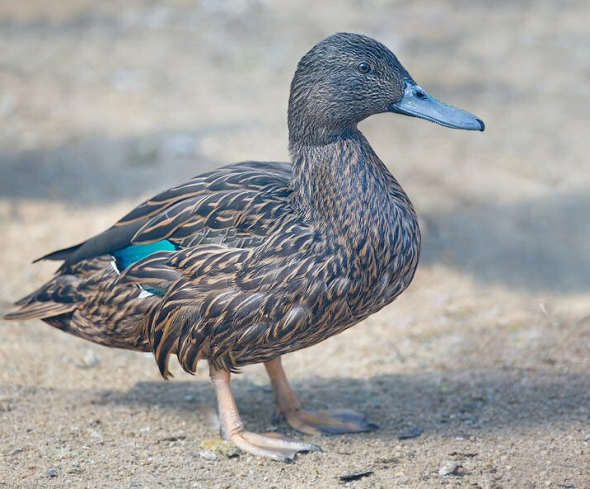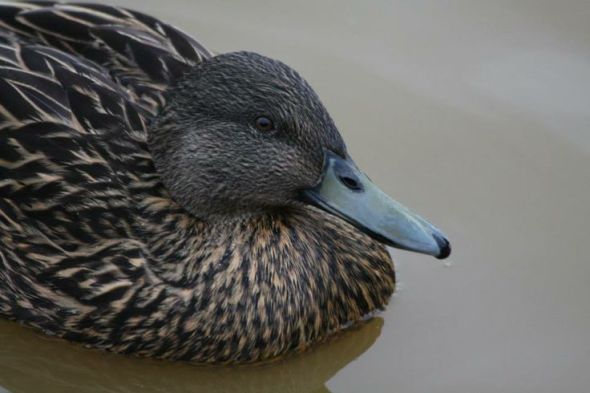ENDANGERED SPECIES FRIDAY | EQUUS FERUS CABALLUS | WILD HORSES OF NAMIBIA.
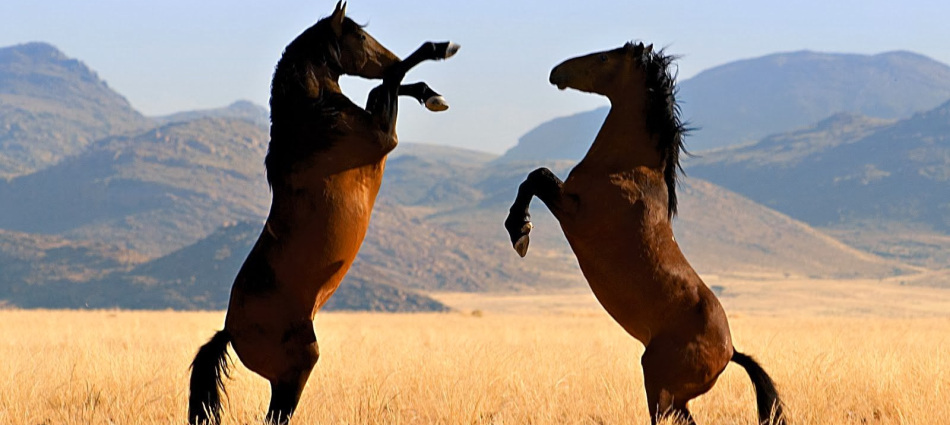
ENDANGERED SPECIES FRIDAY | EQUUS FERUS CABALLUS
This Fridays Endangered Species Post focuses on a sub species of the E. ferus that inhabits the plains of Namibia, Africa. Image: Klein-Aus Vista - E. F. Caballus.
The species (E. ferus) I believe was identified by Professor Carl Von Linnaeus back in 1758 of which identified quite a large number of horses to be precise, however the E. F. Caballus originates from around 1915. Carl Linnaeus born (23 May 1707 – 10 January 1778), also known after his ennoblement as Carl von Linné was a Swedish botanist, physician, and zoologist, who formalised the modern system of naming organisms called binomial nomenclature. He is known by the epithet “father of modern taxonomy”. Many of his writings were in Latin, and his name is rendered in Latin as Carolus Linnæus (after 1761 Carolus a Linné).
E. F. Caballus isn’t listed on the IUCN Red List that I myself can locate (although is endangered). From 1965 the species was listed as (incredibly rare). Then ‘sketchy reports’ state from 1986 to 1996 the species went completely extinct within the wild, there is no evidence to back this claim up though.
From 2008 the species was ‘allegedly’ re-discovered and listed as critically endangered (although as explained there is no criteria on the IUCN Red List relating to this sub-species). Come 2011 populations had somewhat increased slightly placing the species in the band of endangered?. The criteria relating to extinction I am currently looking into as I believe this report ‘could be incorrect’. There is certainly some image evidence (although not proven) that shows a species ‘identical to the Namibian horse’ during the so called extinction period from 1986-1996. However the sub-species has been reported on since the 1940’s.
From what I know the species is a rare feral desert horse of which populations are believed to be near extinction level. Populations are estimated to be between 90-160 mature individuals. Namibia wild horses generally lead healthy life’s although during times of extreme drought (during the summer months) is when the species is normally reported to be struggling, with a number of deaths reported annually.
The origin of the Namib desert horse is unclear, though several theories have been put forward. Genetic tests have been performed, although none to date have completely verified their origin. The most likely ancestors of the horses are a mix of riding horses and cavalry horses, many from German breeding programs, released from various farms and camps in the early 20th century, especially during World War I. Whatever their origin, the horses eventually congregated in the Garub Plains, near Aus, Namibia, the location of a man-made water source.
During the 1980’s the species was virtually eradicated because locals disliked the horses trampling and eating their crops. Fortunately up until the 1980′ the species has lived a virtually hassle free life. Humans rarely if at all bother them, and there is no evidence to prove the species is under threat from hunters, or the African medicine/animal parts trade. Furthermore there doesn’t appear to be any evidence of poaching neither which is good.
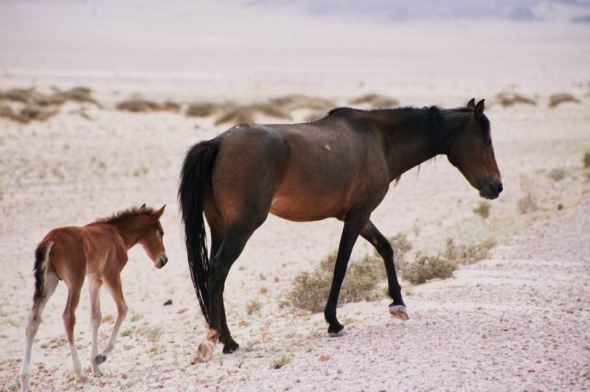
Image: Namibia desert horse and foal.
Namibian wild horses host a number of ‘wild predator threats’ though such as hyenas, blacked backed jackals, and leopards too. Young horses (foals) are normally taken by predators, however adults rarely aren’t.
The harsh environmental conditions in which they live are the main driver of mortality among the Namib desert horse, as they cause dehydration, malnutrition, exhaustion and lameness. Other large plains animals, including the mountain zebra, may have once sporadically utilized the area for grazing during periods of excess rainfall, but human interference (including fencing off portions of land and hunting) have eliminated or significantly reduced the movement of these animals in the area.
The endangered Hartmann’s mountain zebra does exist in the Naukluft Mountain Zebra Park portion of the Namib-Naukluft Park, but their range does not intersect with that of the Namib Desert Horse.
SOURCE: HORSE JUNCTION.
From what I know there is no evidence of wild horses inhabiting anywhere within ‘Southern Africa’, so the theory is these horses may have been imported by the Germans during the last World War, of which after the war the horses were eventually set free to do as they please. While there are numerous speculations and stories - we’ll never truly know where these horses have originated from. Furthermore due to interbreeding genetic testing has proven to be somewhat of a failure too in establishing the true origins of these magnificent beasts.
SOURCE HORSES AND GHOST TOWN CNN.
A further theory although not proven touches on a large vessel carrying thoroughbreds to Australia that unfortunately wreaked near the Orange River. On breaking up the strongest horses are ‘believed’ to have swam ashore to the Garub Plains, the home of the Namib Desert Horse, near Aus, Namibia. As explained though to date there is still no evidence to prove where these horses originated from, moreover all theories haven’t a single scrap of evidence to back such claims up.
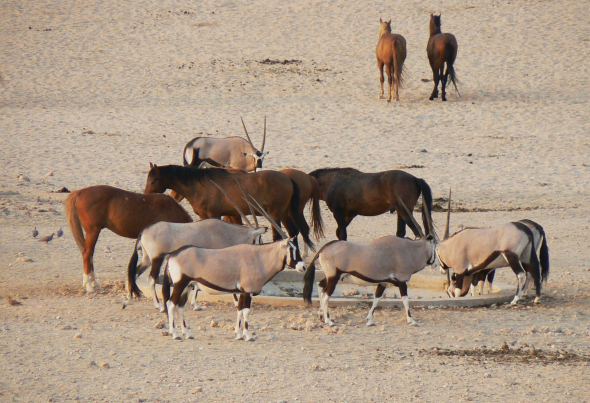
Image: Namibia wild horses drinking at water hole.
One of the biggest threats that could today threaten the wild horses of Namibia is that of water shortages. For now we know the horses normally occupy areas where there is sufficient water holes, large man-made or natural lakes. With drought and climate change becoming more problematic within many Southern African countries its likely we ‘could see species extinction occur in as little as five to ten years’.
All the wild horses in the world, with the exception of a single population, originate from domestic stock. Horses were domesticated on the Eurasian steppes 5,000 to 6,000 years ago, and have been in service to humankind ever since. It was on the horse’s back that civilization advanced. Countries were explored, wars were fought, agriculture and industry progressed at the expense of the horse’s freedom.
The only horse population that was never domesticated, and still exists in its true genetic form, is Przewalski’s Horse or the Mongolian Wild Horse. So extinction could occur very soon simply because the Namibia wild horse’s natural born living instincts haven’t really adapted to the extreme wilds of Africa hence why they are commonly located around man-made or natural water sources, and human settlements?
It was reported this year back in April that drought has been responsible for many species of animals dying due to lack of water and available fresh food sources which has prompted the Namibia Wild Horses Foundation (NWHF) to appeal for funds or good quality grass during this more severe period to see the horses through the winter. NWHF was established in 2012 to monitor the well−being of the horses and to marshal funds for buying feed when the need arises during the drier cycles.
Back in April (2016) the (NWHF) stated there is little grass in the horses’ range as the drought has severely affected the central and southern parts of the country. “The foundation fears that without rain there will be virtually no grass left by the onset of winter and as the horses’ condition further deteriorates, numbers will begin to drop dramatically,” the statement reads. Spring is also now approaching Africa of which we may see further prolonged droughts, and even more deaths.
The foundation also expressed gratitude for all generous contributions for the horses during the past six months. This, it said, has provided supplementary feed – a quarter to a third of the horses’ nutritional requirements — in the form of grass and lucern and protein licks, and will sustain the herd until the beginning of June when the next phase will need to be implemented to ensure their survival; (this period is now over and donations are greatly needed to keep these horses alive). If you’d like to donate to the (NWFH) please click the donate button here: DONATE.
Concerning: The April report also highlighted that some 100 ‘old horses and some fouls’ had sadly perished since the beginning of the drought, which to date leaves exactly 160 mature individuals remaining within the desert of Namibia.
Donations to buy grass or lucern for the horses can be made to Namibia Wild Horses Foundation, First National Bank, current account 62246659489 Klein Windhoek branch ( code 281479) and swift FIRNNANX.
The future is uncertain for the species, in my humble opinion I doubt these horses are going to be inhabiting the desert much longer due to the harsh impacts of climate change increasing every year on the African continent. Furthermore due to the species not really having any ‘natural wild instincts from their ancestors’ they’ll continue to rely on humans just to stay alive. If you’d like to help the species please do so via contacting the Namibian Non-Governmental-Organisation above and donate what you can. Alternatively you can I believe volunteer to help preserve Africa’s only wild horse populations known.
Thank you for reading.
Dr Jose C. Depre PhD. MEnvSc. BSc(Hons) Botany, PhD(NeuroSci) D.V.M.
Master of Environmental, Botanical & Human Science.
Endangered Species Friday: Anas melleri.
Endangered Species Friday: Anas melleri
This Fridays Endangered Species watch Post (ESP) focuses on a very undocumented bird known scientifically as Anas melleri and commonly known as the Meller’s Duck.
The Meller’s Duck was identified back in 1865 by lawyer and Doctor Philip Lutley Sclater FRS FRGS FZS FLS (4 November 1829 – 27 June 1913) was an English lawyer and zoologist. In zoology, he was an expert ornithologist, and identified the main zoogeographic regions of the world. He was Secretary of the Zoological Society of London for 42 years, from 1860–1902.
Listed as endangered, populations are on the decline quite extensively throughout the birds entire range. A. melleri qualified for (endangered status) back in 2012. Endemic to Madagascar the species can be located on the eastern and northern high plateau. Populations are isolated on massifs on the western edges of the plateau. Documented reports from the west of the island most probably refer to vagrant or most likely wandering birds.
Its been alleged that at some time from 2012 re-introduced populations on the island of Mauritius are now extinct - however there remains no hard hitting evidence to back this claim up, conservationists have stated that a ‘probable extinction’ occurred on the island.
The Meller’s Duck was once described as common on the Africans island of Madagascar, unfortunately there is no evidence to back this claim up either. Conservationists that visit the island regularly from International Animal Rescue Foundation Africa and have documented on the Meller’s Duck previously have been informed by locals that the species is rarely seen, however huntsmen will peddle the meat of ducks into local villages.
International Animal Rescue Foundation Africa stated the species had been documented by explorers as ‘densely populated’ on the island from the 1500’s to 1800’s. Sadly since human colonization increased on the island after the French protectorate from the mid 1800’s human population growth on the island has attributed to current decline of the species. Over the last twenty years human population has skyrocketed significantly which unfortunately has led to vast swathes of habitat destroyed and illegal poaching to occur.
“All birds seem to be within a single subpopulation which is probably continuing to decline rapidly. Extinctions are likely to occur in under a few years, five years max”…
Conservation teams like the local communities have confirmed that the species is sadly no longer common ‘anywhere’ other than forested areas of the northwest and in the wetlands around Lake Alaotra where there are some breeding pairs, but where many non-breeders collect, with up to 500 birds present. All birds seem to be within a single subpopulation which is probably continuing to decline rapidly. Extinctions are likely to occur in under a few years, five years max!.
Population sizes are incredibly depressed. We now know the species numbers at 2,000 to 5,000 individuals which equates to exactly 1,300 to 3,300 mature individuals. Should pet collection, poaching, habitat destruction Etc continue at the rate it is extinctions will as explained occur in roughly (730 days). That’s how serious the problem is.
Conservation projects are underway of which the IARF have contributed funding towards the Durrell Wildlife Conservation Trust. The species occurs in at least seven protected areas, and is known from 14 Important Bird Areas (78% of eastern Malagasy wetland IBAs) (ZICOMA 1999). No regular breeding sites are known. In 2007, there was a drive to increase the number of institutions that keep the species in captivity, and as such the bird is a nationally protected species.
Conservation actions planned: Protect remaining areas of least-modified wetlands at Lake Alaotra. Conduct wide-scale status surveys of eastern wetlands. Study its ecology to identify all causes of its decline and promote development of captive breeding programmes.
(Please note all new monetary and equipment grants provided by IARFA from August of last year to present has yet to be updated into the main transparency register onsite)
Meller’s duck breeds apparently during most of the year except May–June on Madagascar, dependent on local conditions; the Mauritian population has been recorded to breed in October and November (however as explained is likely to now be extinct). Unlike most of their closer relatives—with the exception of the African black duck—they are fiercely territorial during the breeding season; furthermore, pairs remain mated until the young are.
Threats
A. melleri is still classed as the largest species of wildfowl found in Madagascar and is widely hunted and trapped for subsistence (and for sport). Interviews with hunters at Lake Alaotra suggest c.450 individuals are taken each year, constituting 18% of the global population.
Long term deforestation of the central plateau, conversion of marshes to rice-paddies and degradation of water quality in rivers and streams, as a result of deforestation and soil erosion, have probably contributed to its decline too. Widespread exotic carnivorous fishes, notably Micropterus salmoides (although this may now be extinct) and Channa spp., may threaten young and cause desertion of otherwise suitable habitat.
Its decline on Mauritius has been attributed to hunting, pollution and introduced rats and mongooses as well as possible displacement by introduced Common Mallard Anas platyrhynchos. Pairs are very territorial and susceptible to human disturbance.
Extinction is likely to occur of which continued protective captivity projects must increase for the birds future survival and re-introduction elsewhere.
The video below depicts a Meller’s Duck captivity project in Germany.
Thank you for reading.
Dr Jose C. Depre
info@international-animalrescue-foundation.org.uk
http://www.speakupforthevoiceless.org
Please donate to SAYNOTODOGMEAT.NET < Click the link - contact@saynotodogmeat.info

